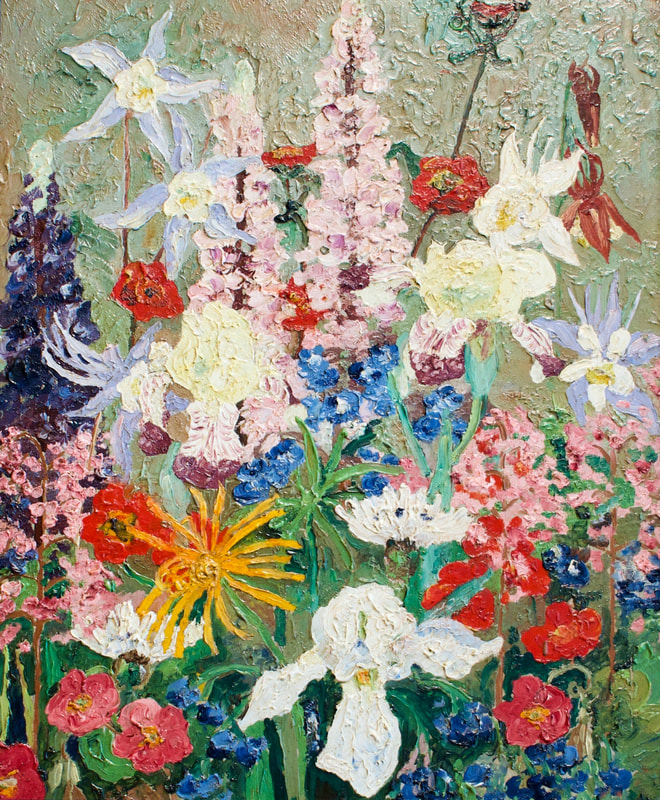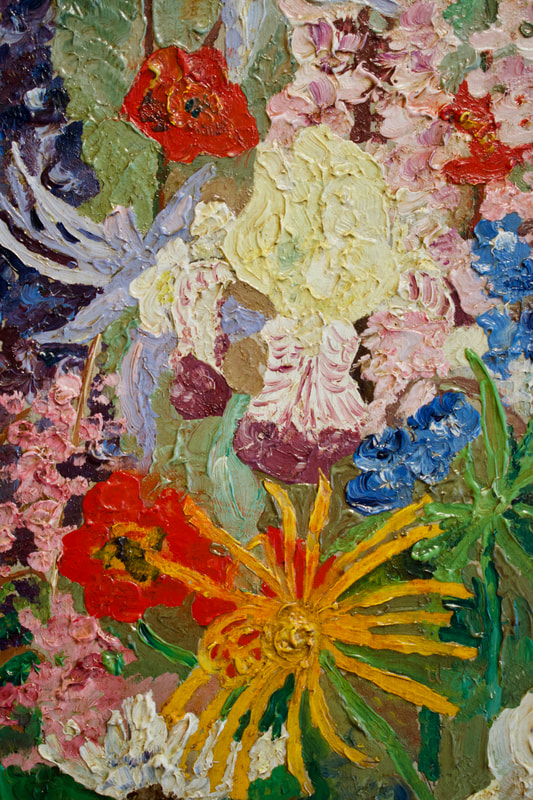|
Cedric Morris 1889-1982 Summer Flowers c.1930 Oil on mahogany panel 18 x 14 3/8 inches (45.5 x 36.5 cm) Cedric Morris achieved fame both as painter and plantsman. Exploding with colour and pulsating with life, his flower paintings were a glorious synthesis of both these passions. In Summer Flowers we see Irises - for the breeding of which Morris achieved considerable fame - alongside poppies, delphiniums and saxifrage, among many others. They are rendered in thickly applied paint and pleasing impasto, much in the manner of Van Gogh. Morris creates a tight composition which fills virtually the entire picture space, the blooms standing shoulder to shoulder in a ravishing wall of colour and texture. Such was his plant knowledge that Morris usually painted such pictures indoors from memory, board propped on his knees and only occasionally required a flower for reference. Morris was essentially a painter, not a botanist. In his paintings he quite happily adapted flower colours from reality to create just the right harmony and impact. Ultimately Morris was a colourist, using plants as a medium to express colour and create a joyous emotional response in the viewer. In both his gardens and his paintings Morris exercised strict control over colour harmonies and combinations; red poppies were rooted out, while soft mauve and grey ones were permitted to flourish. Salmon pink was mocked as ‘knicker pink’. The flowers in Morris’s gardens were set out with a painter’s sensibility, like contrasting and complementary colours on a palette. Morris created two famous gardens, the first at The Pound and the next at Benton End, both in Suffolk. His aim he said was to make a creative environment akin to Monet’s Giverny garden, which he was familiar with. In the Twenties Morris and his life partner Arthur Lett-Haines - always known as Lett - spent considerable time in Paris and on the Mediterranean with the chic travelling avant-garde, close friends with Jean Cocteau, Ernest Hemingway, Man Ray and Picabia, Christopher Wood and Tony Gandarillas. They held famous and very glamorous parties, and Morris was so successful that at his exhibition at Arthur Tooth’s in 1928 thirty one pictures sold at the private view alone. But Morris was also a classic English eccentric, in the best sense. Despite another sell out show with Tooth’s he cancelled his contract, and rebuffed the honour of becoming a Royal Academician. Instead in1930 Morris and Lett left London and Paris behind them and settled permanently in Suffolk to enjoy an idyllic rural life of painting, gardening, cooking - and teaching. In 1937 they opened the East Anglian School of Painting and Drawing which was an immediate runaway success, numbering sixty students in the first term alone. There was a nurturing, friendly environment at the school which allowed students to flourish and grow. Among their early students was Lucien Freud, who remained throughout his life a staunch advocate of Morris’s modern painting and an admirer of his uniquely nurturing personality (which even forgave Freud’s carelessly discarded cigarette being the cause of the accidental burning down of their first school building). ‘Cedric taught me to paint’, Freud wrote simply; ‘He did not say much, but let me watch him at work. I have always admired his paintings and everything about him’. |
Proudly powered by Weebly


